|
TENKARA - PATAGONIA
By Piero Letizia
As promised in my previous article, I left Italy to reach Marco Bellucci at his fishing lodge in San Martin de Los Andes in Patagonia, where he was ready to assist me in testing out TENKARA DRY PL on some of the marvelous nearby waters.
The technique I used was the same I had developed with fly-fishing called PL&EC (Progressive Lines & Easy Casting), adaptable to Tenkara with some restrictions. Almost all tests were focused on “dry fly fishing” to achieve complexity, pleasure and system enhancement.
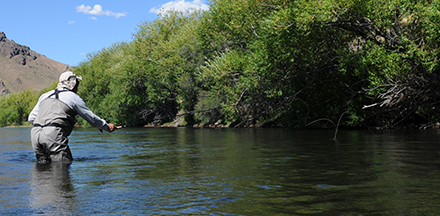
EXPERIMENTS - STARTUP
Only one chance to go to Patagonia for six days, take it or leave it! After a quick chat with Marco via Skype, I decided to join him, also persuaded by the low water levels that were enabling the trout migration to the lakes.So, in a few hours I packed everything I needed for this trip, including premium Japanese Tenkara equipment and some specific fly-lines finely tuned for this fishing occasion.
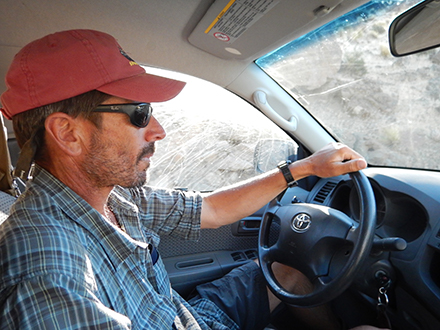
There I was, on a thirteen hour flight to Buenos Aires and from there onto another two-and-a-half -hour flight to Bariloche, where Marco would be waiting for me to drive me to his lodge four hours away. Once arrived, both exhausted by the trip, we decided to start planning the following days. Marco had fished the rivers and lakes of the region in the past two
months and his recent experience and suggestions were crucial for our the future arrangements.
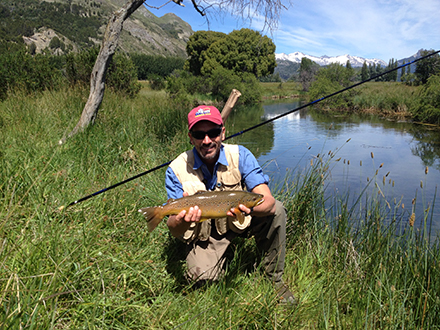
THE LODGE
Just by looking at the picture, even if it is taken from the outside, one immediately realizes the beauty of the structure: “Mirador Nires” lodge is located in a beautiful
residential area, 8 km from San Martin De Los Andes, on top of a hill from which you enjoy a great view of the surrounding mountains and the majestic Cerro Chapelco. Moreover, this location is strategic for reaching the best river spots in the region.
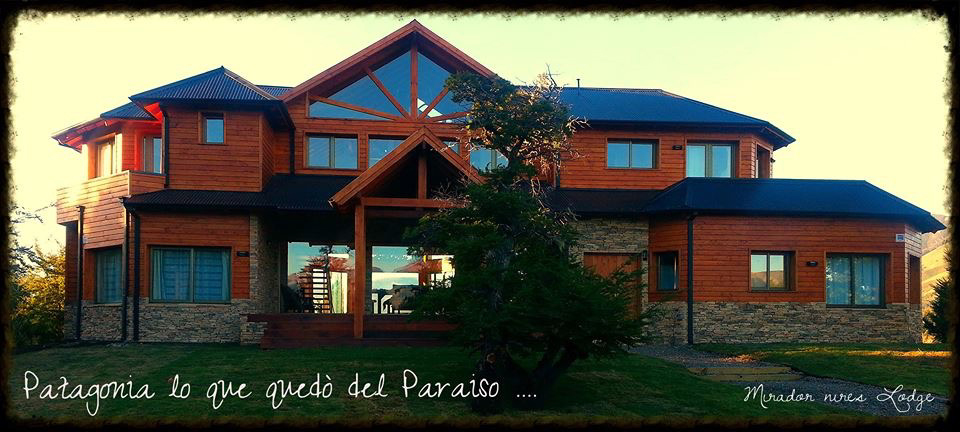
The next day, after a good night sleep, we were ready to start our new adventure on Rio Chimehuin, Rio Malleo, Rio Meliquina, Filo Hua Hum river and its homonymous lake. Marco’s decision for these rivers was based on recent water levels, temperatures and the good fishing results obtained over the past months.
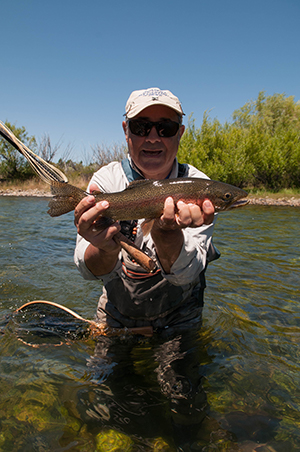
Well, the fishing was great in terms of quantity and quality of the catches. Few small sized fish, with an average of 40 cm, and some nice ones up to 54 cm, a very reasonable size for Tenkara!. We were really pleased with the fishing results, considering the low level and high temperature of the rivers, but we were even happier about the performance of our equipment that proved to be perfectly balanced with the DRY PL fly casting technique.
Thanks to Marco, who kindly spent most of the time taking pictures and shooting videos, it is now possible to show you some special presentations which enabled me to catch fish on dries in several difficult conditions like strong wind and critical dragging!
I would like to say that, except for belly boat fishing on the lake, it was really easy to catch fish using any kind of Tenkara equipment, and that all casting experiments on the rivers proved to be particularly successful. The rivers chosen were medium to large in size and in many cases we needed to change the lengths of our fly lines up to mt.8,50. In consideration of the strong wind persistently blowing during our fishing activity, the perfect combination of the equipment tested was:
Rod - Length mt. 4,00
Fly Line - DT2 mt. 6,15 and 7,15
Leader - Mono leader 9’ length and size 0x / 1x / 2x
Tippet - Sizes 2x + 3x + 4x of total length 1,20 and 1,50
Fishing technique: Dry PL

TENKARA EQUIPMENT
Thanks to Alberto, from “The ITALIANS” we have had the opportunity to make experiments also with premium Japanese material which allowed me to obtain great results like:
- complex casting presentations
- many catches
EQUIPMENT LIST
Nissin Rods
Air Stage Ryu mt. 4,10 6:4
Air Stage Honryu 4,50 6:4
Zerosum mt. 4,00 7:3
Kawashi Professional mt. 3,90 7:3
Kawashi Professional mt. 3,60 7:3
Pro Square mt. 4,50 7:3
Pro Square mt. 4,50 8:2
Sakura Rods
Kongo Sekirei 3,60 6:4
Kongo Betsuatsurae 3,90 7:3
Lines various firm
FLY LINES
DTF 02 6 mt
DTF 02 7 mt
DTF 03 8,5 mt
DTF 03 9mt
LEVEL “Prototype 0,25”
FURLED
Line different type
LEVEL LINES
Line different type
Leaders of various brands
Mono leader 9’ x 0/ 1 / 2 / 3
Here’s an idea of what is possible with Tenkara using a new approach:
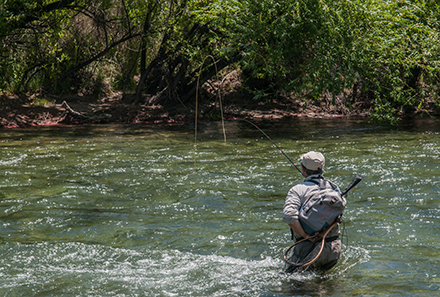
A remarkable wide and vertical mending in the air with a 5 mt leader and fly in action
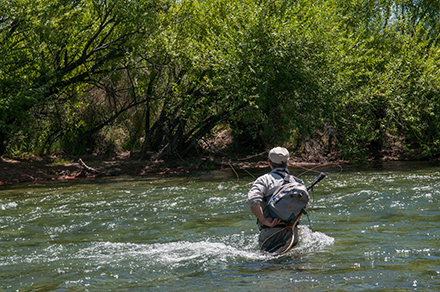
Complex upstream loop in the air
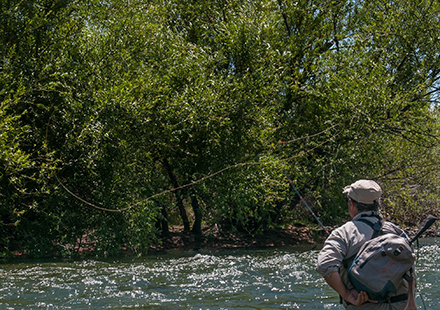
Straight cast with a high upstream loop to guarantee dragging delay
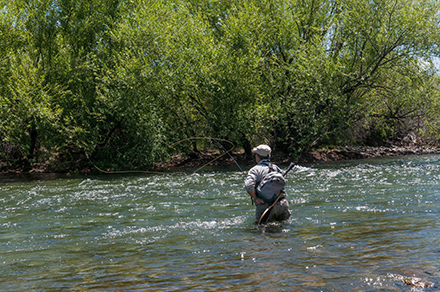
A complex upstream loop in the air
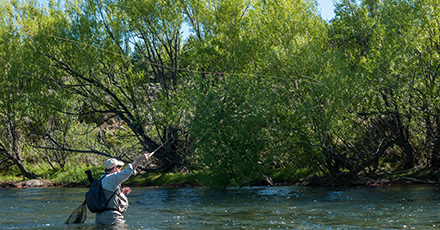
Tight loop - Controlled straight cast - Development of a mending in the air
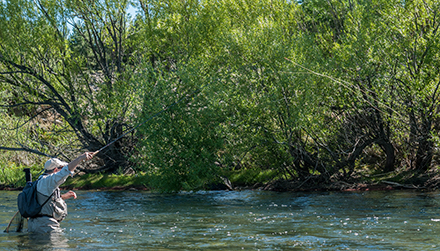
...similar approach to generate and control a mending in the air
All the above was possible thanks to my personal fly fishing technique called “PL & EC” (Progressive Lines & Easy Casting) perfectly adaptable to Tenkara as “DRY PL”. But what are the basic differences between “DRY PL” and “traditional” Tenkara? Well, not much in terms of fishing gear and basically a great difference in terms of casting!
Let’s analyse the issues contained in following tables:
| TRADITIONAL |
DRY PL |
ROD
- any brand
- action preference 6:4 - 5:5
|
ROD
- made in Japan preferred
- action preference 7:3 - 6:4
|
| LINE - Braided Line or Mono Leader |
LINE - Fly Line DT
- DT2 F for action 7:3
- DT1 or lighter for action 6:4 and 5:5
|
| Leader - None |
Leader: Depending on type of water 9'/7'6" |
| TIPPET: Short - 1 or 2 sizes |
TIPPET: Long - 2 or 3 sizes |
| FLIES: Kebari |
FLIES: Kebari and generic |
| GENERAL TOOLS - Yes |
GENERAL TOOLS - Yes |
CASTING TECHNIQUE
DRY PL - coming from "PL & EC" (Progressive Lines & Easy Casting)
Technique focused on the following main criteria:
- accurate selection of quality rod
- right choice of the line's profile and its weight depending on the rod in use and the specific casts to generate (e.g. the most of the actions shown in the above casting slides, concerning mending and spirals in the air, has been possible by the use of a DT2 F fly-line, a 4 m rod 7:3 action and the specific casting technique)
- Progressive acceleration during the back and forward casting actions, with care of not exceeding the sufficient power TO USE and working on a wide and straight plane in order to generate complex fly presentation scheme
(NOT APPLICABLE in TENKARA only with Fly-Casting PL & EC) use of the left hand,
positioned mostly in a high position, as follows:
- up to mt. 20/22 - coordinate movements between the left hand and the first ring of the rod in order to maintain the tension of the fly-line
- over mt. 24 - progressive acceleration to improve the distance and the right projection of the fly as first landing element over the water
special grip limited at three fingers, index, medium and thumb. This to guarantee the right movements of the rod during the casting action and generate tight loops on different planes with less effort
Casting based on the following water’s landing criteria: 1. Fly 2. Leader 3. Line
Generation of progressive and modular movements to make and control special casts
Take Note: it’s not always simple to explain how to coordinate a cast based on the above mentioned points, but is important for the moment to keep these ingredients in mind.
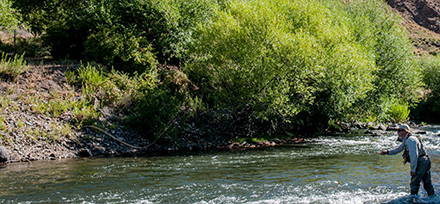
Wide and repeated downstream spirals to present the fly first
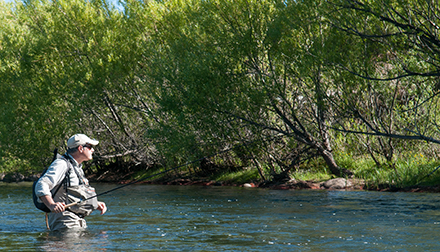
A rearward position of the right hand to manage a shoot under the trees with a long fly-line and leader
CONCLUSION
Even though the time we devoted to testing was limited, we fully achieved the expected results.
Following the final considerations:
- All equipment made in Japan was over my expectations, in particular the rods which allowed, using a professional casting technique (DRY PL), the execution of complex casts and presentations
- Tenkara can be developed from a native fishing technique practiced on small streams fishing wet flies and catching small fish (typical of Japan ) to a dry fishing technique on wide waters and catching big fish
- Great potential of Dry PL Technique adapted to Tenkara
- Profitable use of the DT 2 line: it proved to be the ideal choice on most of the rods tested
Experimentation shall continue at my AFCS fishing lodge in Sweden during the next fishing season.
In conclusion, I would like to pay tribute to Marco for his perfect guiding and lodging and for his invaluable assistance as s photographer.
One final suggestion: try TENKARA!
TENKARA, to catch fish with a Beautiful and Native System
By Piero Letizia

|